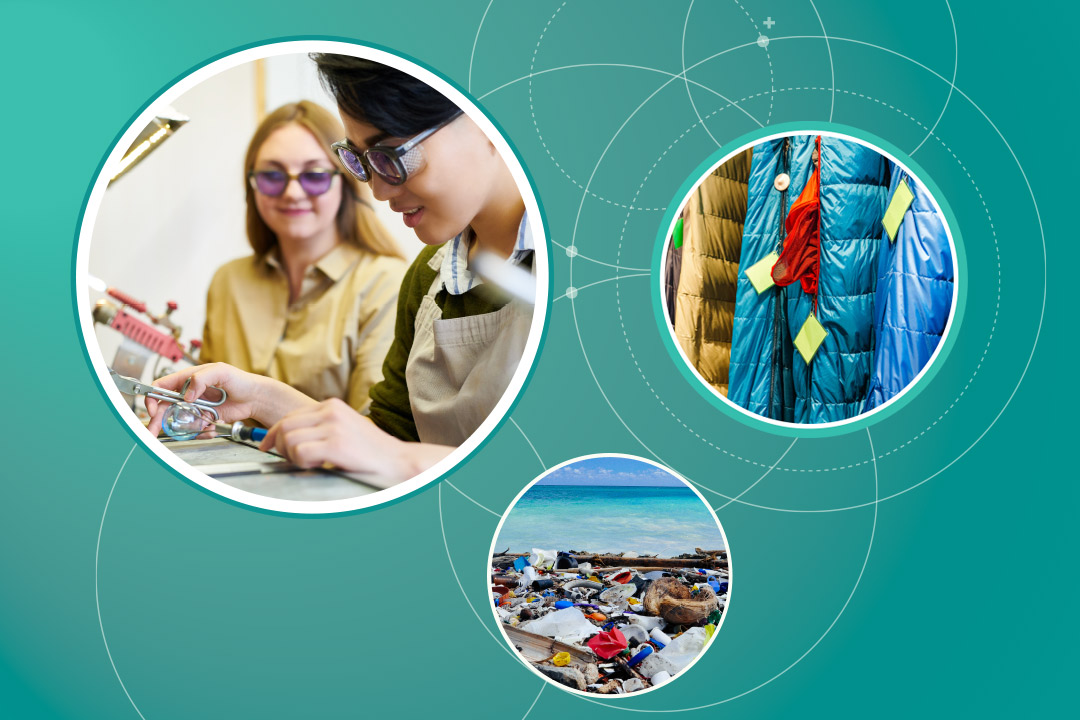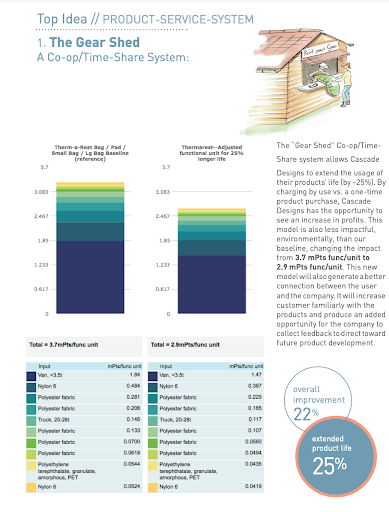
As climate change intensifies around the world, it is urgent for students to understand and utilize the principles of sustainable design in their entrepreneurial pursuits. To help faculty create opportunities for students to engage in green design methods, we’ll spotlight key exercises from the Tools for Design and Sustainability course, developed by Dr. Jeremy Faludi, assistant professor of industrial design engineering at Delft University of Technology (TU Delft). We’ll explore several exercises that will help faculty easily introduce sustainable design concepts in their courses.
Over 2 billion tons of waste are produced annually across the globe, and in the U.S. alone, 139.6 million tons of waste end up in landfills each year. According to the Global Footprint Network, we’ve been running an ecological deficit since the 1970s. We would need 1.75 Earths to sustain our consumption of natural resources if we continue at our current pace.
In Michael Braungart’s influential book Cradle to Cradle: Remaking the Way We Make Things, he writes: “Everything else is designed for you to throw away when you are finished with it. But where is ‘away’? Of course, ‘away’ does not really exist. ‘Away’ has gone away.”
To protect our planet while continuing to improve lives, we need to decouple economic growth from the consumption and disposal of finite resources. That is the core premise of the circular economy, which aims to minimize waste and maximize reuse of existing materials. For example, improving the circulation and reuse of uncontaminated steel could cut 500 metric tons of new steel production by 2050, saving more than 1 billion tons of carbon emissions per year.
As defined by the Ellen MacArthur Foundation, the circular economy is a systems solution framework driven by design to reduce waste production in manufacturing, based on three principles:
- Eliminate waste and pollution
- Circulate products and materials (at their highest value)
- Regenerate nature
For STEM entrepreneurs, the circular economy encourages the transformation of a business model from a one-time purchase to a lifetime service, where the company stays involved for the life cycle of the product. Instead of solely reducing material consumption, innovators can implement closed-loop production practices that reduce environmental harm by increasing the length of time a product can be used and/or the number of people who can use a product within its original life cycle.
Introducing the Principles of Circular Economy Development Into Higher Education
In order to properly equip students with the knowledge and skills needed to innovate for a circular economy, colleges and universities need to provide training on how to implement sustainable design tools. One great example of the role faculty can play in bringing circular economy principles into the classroom comes from Course & Program grantee Taryn Mead from Western Colorado University. She developed a course in 2019 focused on core entrepreneurship concepts through the lens of the circular economy. One of her goals was to prepare students to identify viable opportunities around environmental innovation using waste in rural communities. “In ecosystems, there is no such thing as waste. Every nutrient and particle that is discarded by one organism is food and raw material for another,” Mead said.
Similarly, Course & Program grantee Ranji Vaidyanathan developed a graduate-level course at Oklahoma State University that prepares students to create new businesses by recycling materials. He challenges his class to consider the technical feasibility and commercial viability of their ventures, while testing their ideas using debris from campus construction. “If we teach our students that sustainability and the circular economy can contribute to new products, we can demonstrate to them that it will benefit them in the long run,” Vaidyanathan told us.
Faculty can integrate circular economy concepts into the classroom by introducing sustainable design methodology using instructional activities, such as this circular economy exercise from Dr. Jeremy Faludi’s Tools for Design and Sustainability. Visit the Circular Economy section for additional learning content.
Waste-Free Design and Lifelong Innovation
Circular economy concepts can include designing a product to last a lifetime, designing for a good afterlife (disassembly and recycling), or designing for repair and upgrade. There are innumerable ways students can do this, which is why the following exercise is centered around large-scale brainstorming and then uses metrics to narrow down the list and find the most impactful idea.
Like our biomimicry mentors and green materials exercises, this exercise is designed to provide a level of real-life application: task students with developing ways to weave the principles of the circular economy into their innovation or business model. You can view the original exercise in our Tools for Design and Sustainability Course, but here’s a quick overview to get you started:
- Students brainstorm around 25 ways to introduce closed-loop production and circular economy principles into their business model and/or manufacturing process.
- The list is then narrowed down to the top four ideas.
- Next, students estimate ways to reduce environmental harm caused by the material for each option.
- Finally, students illustrate the top idea and demonstrate how it’s different from their original innovation concept.
Cascade Designs: Weaving the Circular Economy Into a Nature-Focused Startup
At the Minneapolis College of Art and Design, a student team called Cascade Designs that designed sleeping bags and pads developed a number of high-impact ideas to integrate circular economy principles into their business model and product design. Their top idea was a gear shed that utilized a co-op/timeshare system: Customers could rent outdoor gear from Cascade Designs as needed through local retailers or a central Cascade Designs location that carried all of their products.
 After running the numbers, the team discovered that this concept would extend the life cycle of their outdoor gear products by 25% and decrease negative environmental impact as a result of limiting equipment usage and time. By changing their business model from a one-time product purchase to pay-per-use, the team would also be able to increase profits and the company’s connection with its customers.
After running the numbers, the team discovered that this concept would extend the life cycle of their outdoor gear products by 25% and decrease negative environmental impact as a result of limiting equipment usage and time. By changing their business model from a one-time product purchase to pay-per-use, the team would also be able to increase profits and the company’s connection with its customers.
Another idea the Cascade Design team came up with was a service that enabled customers to bring their sleeping bags and pads to a local repair shop when they were damaged, rather than ship them to Cascade Designs. This idea would decrease shipping costs and negative environmental impact, decrease the time the product was unavailable for use by the customer, and increase the life cycle of their sleeping bags and sleeping pads by 25%.
As seen with Cascade Designs, implementing the principles of the circular economy into innovation production and business model development can not only decrease environmental impact but also illuminate new ways to increase profits and connect with a consumer base. Taryn Mead and Ranji Vaidyanathan illustrate how faculty can usher sustainable design into their classrooms and inspire their students to develop environmentally conscious innovations.
Over the next few months, we’ll be sharing more easy-to-implement exercises for your course, in the rest of the Inspiring Sustainable Design series.
Samuel Yoo, a program officer at VentureWell, supports institutions with developing programs involving sustainability-focused science and technology innovation and entrepreneurship. Previously, he researched bioenergy solutions at the Energy & Biosciences Institute, taught STEM disciplines in public schools, and led sustainability initiatives at the University of Illinois Urbana-Champaign.
OPEN 2023 takes place March 21-23 in the D.C. metro area. OPEN brings together faculty, administrators, staff, and students from the STEM fields to share innovation and entrepreneurship experiences and research, learn best practices, and forge dynamic new relationships. One of the conference tracks is Academic Impact, in which speakers will discuss topics like sustainability and sustainable design concepts, tools, and frameworks. Learn more and register now at venturewell.org/open!